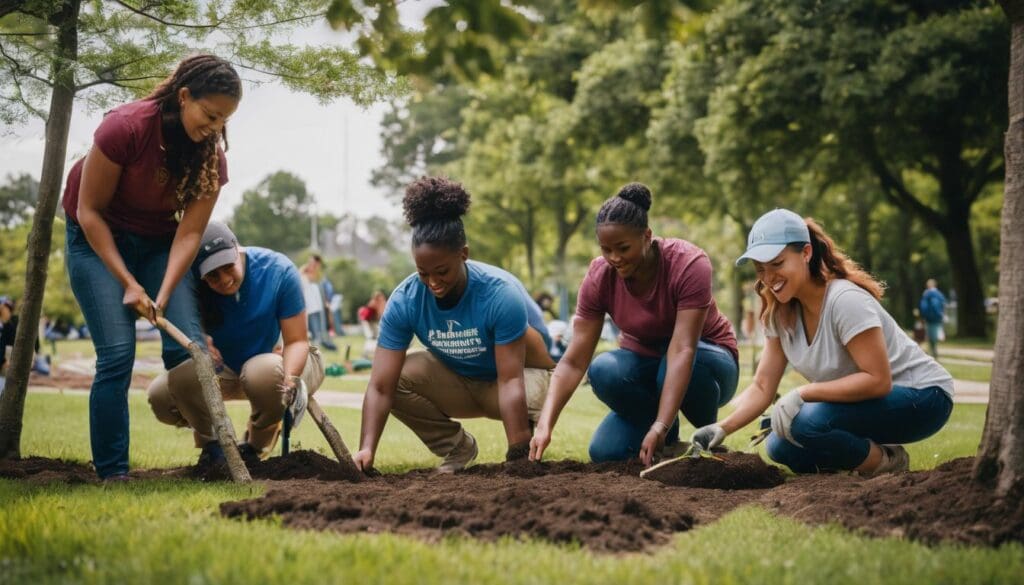Concerned about the environment, many of us feel unsure where to start with local action. It’s a fact that community groups can drive powerful change when they’re well-organised and focused on environmental advocacy.
This blog will guide you through forming an effective environmental group in your community, empowering you to make a real difference. Let’s get started on this green journey together!
Key Takeaways
- Establish a community environmental advocacy group by connecting with experts for technical support, sharing resources, and evaluating who benefits from your actions.
- Engage frontline communities for guidance and feedback, ensuring that environmental justice is central to all initiatives.
- Promote diversity and fight against oppression in the movement while working towards fair distribution of funds to support impacted communities.
- Involve community members through clear goals, education, relationship building, and by providing opportunities for active participation in decision-making.
- Stay adaptable and regularly evaluate your strategies to continue making positive changes within environmental advocacy efforts.
Supporting the Environmental Justice Movement
Assist with technical support when needed, create spaces for resource sharing and networking, critically evaluate who benefits from actions and solicit guidance and feedback from frontline communities.
Incorporating Environmental Justice: Make diversification and anti-oppression part of the work, work toward a more just distribution of funds, and use established platforms to support frontline communities.
Provide technical assistance when needed
Offering technical support is essential in the drive for environmental protection. Experts with knowledge in sustainability, conservation practices, or policy development can guide groups through complex issues.
Equip your community environmental advocacy group with the necessary tools and expertise to navigate legal frameworks, analyse data effectively, or implement cutting-edge solutions that enhance conservation efforts.
Mentors and skilled professionals can deliver workshops or training sessions on various topics such as effective community organising or utilising digital platforms for wider outreach.
This enables group members to elevate their advocacy strategies within the realm of environmental justice and ensures the continuity of grassroots empowerment through education. Strengthen your organisation’s capacity by tapping into a network of specialists who are eager to help you make a lasting impact on environmental stewardship.
Create spaces for resource sharing and networking
Supporting the Environmental Justice Movement involves connecting with like-minded individuals and organisations to share resources and build networks. By fostering a culture of collaboration, we can leverage our collective knowledge, skills, and experiences to advance environmental advocacy efforts.
Encouraging open dialogue and information exchange within the community enables us to pool resources and support each other’s initiatives, ultimately contributing to a more cohesive and impactful environmental justice movement.
This approach ensures that everyone has access to valuable tools, information, and support while amplifying our collective voice for conservation.
Critically evaluate who benefits from actions
When planning and executing environmental advocacy actions, it is crucial to critically evaluate who benefits from these efforts. This involves ensuring that the outcomes positively impact frontline communities, marginalised groups, and the environment as a whole.
By prioritising the needs of these stakeholders, an environmental advocacy group can work towards creating real and equitable change. It also means examining potential unintended consequences to avoid perpetuating any existing social or environmental inequalities.
Furthermore, such critical evaluation allows for transparency in decision-making processes and fosters accountability within the advocacy group. Prioritising this assessment helps ensure that all actions are aligned with the principles of justice and sustainability, benefiting both present and future generations while amplifying community voices.
Solicit guidance and feedback from frontline communities
As part of supporting the environmental justice movement, it is vital to actively solicit guidance and feedback from frontline communities. By listening to the perspectives and experiences of those directly impacted by environmental issues, we can gain valuable insights that inform our advocacy efforts.
Engaging with frontline communities ensures that their voices are heard, their needs are addressed, and their priorities are central to the decision-making process. This collaborative approach empowers communities and strengthens the effectiveness of our collective environmental advocacy.
To further advance our environmental justice goals, it is essential to create spaces for meaningful dialogue where frontline community members feel valued and respected. This fosters mutual understanding, builds trust, and ultimately contributes to more inclusive and impactful environmental advocacy initiatives.
Incorporating Environmental Justice
Ensure that diversification and anti-oppression are integral to the work, promote a more just distribution of funds, and use established platforms to support frontline communities.
Ready to learn more about how to make a difference in your community? Keep reading!
Make diversification and anti-oppression part of the work
Incorporating diversification and anti-oppression into environmental advocacy is crucial for creating an inclusive and equitable movement. By embracing diversity within the group, a wider range of perspectives and experiences can be represented, leading to more comprehensive solutions to environmental issues.
This can involve actively seeking out individuals from marginalised communities, providing them with opportunities to lead and contribute to decision-making processes, as well as acknowledging and addressing systemic oppression within environmental movements.
Prioritising these efforts ensures that the work is truly representative of all voices within the community.
Furthermore, it’s essential to challenge existing power structures that perpetuate oppression in environmental work. This involves examining how funding is distributed and advocating for a more just allocation of resources towards frontline communities who are disproportionately affected by environmental challenges.
Work towards a more just distribution of funds
By prioritising a more just distribution of funds, the community environmental advocacy group aims to ensure that financial resources are allocated equitably, benefiting marginalised communities and initiatives.
This involves actively seeking out funding opportunities and advocating for fair allocation processes across various projects and programmes.
At the heart of this effort is the commitment to address economic disparities within environmental activism, promoting fairness and inclusivity in resource distribution. This approach nurtures trust and solidarity among diverse groups while advancing sustainable community development.
Use established platforms to support frontline communities
Utilise well-known platforms to aid frontline communities in advancing environmental justice. Engage with existing networks and organisations to amplify the voices of those most affected by environmental issues.
Facilitate access to resources and opportunities, leveraging established platforms for greater impact in advocating for equitable environmental policies.
Expand the reach of frontline community efforts through partnerships with established entities, fostering collaboration towards sustainable solutions that benefit all stakeholders involved in conservation advocacy and grassroots activism.
Engaging Community Members
Identify the goals and target audience for your advocacy efforts. Build trust and relationships within the community, providing information and education to empower members to get involved in environmental activism.
Identify goals and audience
Set clear and achievable goals that align with the needs of the community.
- Define specific objectives that align with the environmental concerns of the community. Ensure they are measurable and attainable.
- Understand the audience by conducting thorough research on their demographics, interests, and existing knowledge of environmental issues.
- Engage with community members to gather insights into their priorities, values, and aspirations concerning environmental conservation.
- Collaborate with local leaders and organisations to gain a deeper understanding of the community’s environmental advocacy needs.
Build relationships and trust
Engage with community members actively and respectfully. Listen to their concerns and priorities, seeking feedback to shape the group’s actions effectively. Foster an inclusive environment where all voices are valued and heard, ensuring that trust is built through transparency and accountability.
Share successes and challenges openly while staying committed to building lasting connections within the community.
Approach each interaction with empathy, understanding the diverse perspectives of those involved in environmental advocacy. Demonstrate genuine care for community well-being through consistent communication and meaningful engagement.
Provide information and education
Building relationships and trust within the community is crucial for gaining support for environmental advocacy efforts. Empower community members with information and education about environmental issues to inspire action and engagement.
Offer accessible resources, workshops, and events focused on raising awareness about conservation, environmental justice, and grassroots activism. Utilise various communication channels to distribute relevant materials and provide platforms for open dialogue.
Engage community members through targeted educational initiatives to cultivate a strong understanding of environmental challenges. Use clear language and relatable examples that resonate with diverse audiences.
Involve and empower community members
Engaging community members in environmental advocacy is vital for creating meaningful change. Identify the specific goals and audience to tailor your outreach efforts effectively. Focus on building relationships, trust, and providing relevant information and education within the community to foster empowerment.
Encouraging active participation from local residents will ensure that their voices are heard and valued in the decision-making process.
Empowering community members through involvement allows for diverse perspectives to be considered, enriching the overall impact of environmental activism. By involving individuals in conservation efforts, you can ignite a sense of ownership over shared environmental issues, fostering a deeper commitment towards sustainable practices within the community.
Adapting and Evaluating Strategies
Stay adaptable and assess the effectiveness of your strategies regularly to ensure you are making a positive impact. To learn more about how to organise a community environmental advocacy group, keep reading!
Adapt to changing situations
When facing new challenges, be prepared to adjust your strategies accordingly. Regularly evaluate the effectiveness of your approach and make necessary changes. Stay flexible and open-minded to emerging opportunities that can further the impact of your advocacy efforts.
Embrace innovation and creativity as you adapt to changing circumstances. Seek feedback from community members and frontline communities, leveraging their insights for a more responsive and inclusive approach.
Stay alert to evolving environmental issues, ensuring that your group remains relevant and impactful in addressing pressing concerns.
Evaluate the effectiveness of strategies
To ensure our strategies are impactful, we regularly assess their effectiveness. This involves measuring the outcomes and impact of our actions, as well as collecting feedback from community members.
By staying flexible and open to adapting our approach based on these evaluations, we can continuously improve our efforts towards environmental justice.
Regularly assessing the impact of our strategies is crucial for maintaining an effective advocacy group focused on environmental justice. We must prioritise continuous learning and improvement to ensure that we remain responsive to the needs of frontline communities and have a meaningful impact in supporting conservation efforts.
Conclusion
In conclusion, organising a community environmental advocacy group involves active engagement with diverse stakeholders. Building relationships and trust are vital for empowering community members to take action.
Evaluating strategies and adapting to changing situations ensures ongoing effectiveness in advocating for environmental justice. Creating spaces for resource sharing and networking is crucial in supporting the environmental justice movement.
FAQs
1. How do I start an environmental advocacy group in my community?
Start by organising meetings, engaging with your local community, and providing environmental education to empower people for grassroots advocacy.
2. What activities can a community environmental group engage in to promote awareness?
A group can conduct outreach programmes, organise social actions like clean-up drives, and host workshops on environmental issues to raise community awareness.
3. Why is community engagement important in environmental activism?
Engaging the community ensures that everyone has a voice and contributes to sustainable change through active participation in environmental education and activities.
4. How can we make sure our environmental group’s efforts have a lasting impact?
Keep your group’s approach focused on empowerment through consistent outreach, educating members about their impact, and continually promoting proactive social action within the community.
5. Can joining forces with other organisations strengthen our advocacy work?
Yes! By teaming up with other groups or networks you expand your resources and influence for more effective community organising around shared goals of improving the environment.





